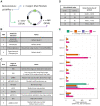Joint universal modular plasmids (JUMP): a flexible vector platform for synthetic biology
- PMID: 33623824
- PMCID: PMC7889407
- DOI: 10.1093/synbio/ysab003
Joint universal modular plasmids (JUMP): a flexible vector platform for synthetic biology
Abstract
Generation of new DNA constructs is an essential process in modern life science and biotechnology. Modular cloning systems based on Golden Gate cloning, using Type IIS restriction endonucleases, allow assembly of complex multipart constructs from reusable basic DNA parts in a rapid, reliable and automation-friendly way. Many such toolkits are available, with varying degrees of compatibility, most of which are aimed at specific host organisms. Here, we present a vector design which allows simple vector modification by using modular cloning to assemble and add new functions in secondary sites flanking the main insertion site (used for conventional modular cloning). Assembly in all sites is compatible with the PhytoBricks standard, and vectors are compatible with the Standard European Vector Architecture (SEVA) as well as BioBricks. We demonstrate that this facilitates the construction of vectors with tailored functions and simplifies the workflow for generating libraries of constructs with common elements. We have made available a collection of vectors with 10 different microbial replication origins, varying in copy number and host range, and allowing chromosomal integration, as well as a selection of commonly used basic parts. This design expands the range of hosts which can be easily modified by modular cloning and acts as a toolkit which can be used to facilitate the generation of new toolkits with specific functions required for targeting further hosts.
Keywords: DNA assembly; Golden Gate cloning; SEVA; modular cloning; synthetic biology.
© The Author(s) 2021. Published by Oxford University Press.
Figures





References
LinkOut - more resources
Full Text Sources
Other Literature Sources
Research Materials
